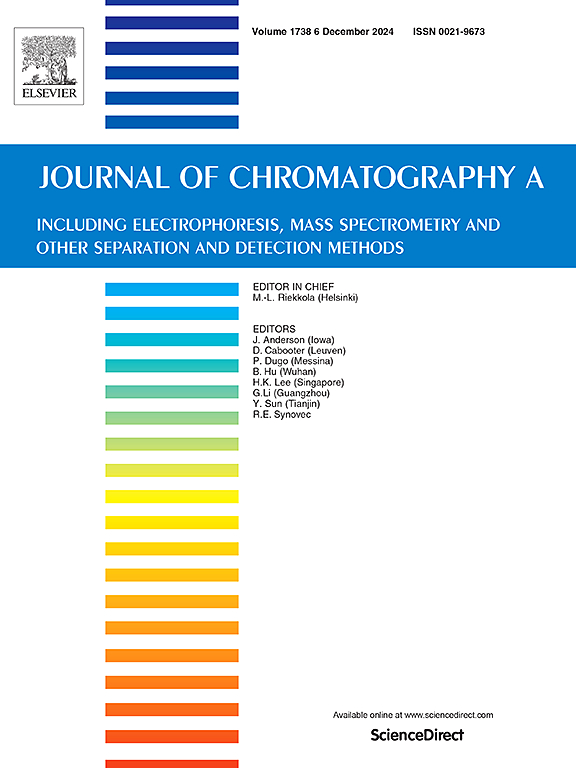Application of magnetic AlFu MOF nanocomposite for the extraction and preconcentration of some pesticides from different distillates
IF 3.8
2区 化学
Q1 BIOCHEMICAL RESEARCH METHODS
引用次数: 0
Abstract
This research used a magnetic AlFu nano-metal-organic framework as an adsorbent for the first time. This approach extracts and preconcentrates eight pesticides from various distillates through a two-step process: magnetic dispersive micro solid phase extraction and dispersive liquid-liquid microextraction. Initially, the nanocomposite is dispersed into a sample solution containing the pesticides and Na2SO4. The target pesticides are then adsorbed onto the nanocomposite, which is subsequently isolated from the aqueous phase using an external magnetic field. Acetonitrile is used to elute the adsorbed analytes pesticides from the nanocomposite surface. The resulting acetonitrile extract, containing the concentrated pesticides, is then mixed with a tiny amount of another solvent and injected into a NaCl solution. Centrifugation allows the organic phase, enriched with the pesticides, to settle down. An aliquot of this organic layer is then analyzed using a gas chromatography-flame ionization detector. Optimization of the procedure led to favorable performance, including good extraction recovery of the pesticides (68–98 %), significant enrichment (enrichment factors of 340–489), a wide range of detectable concentrations (2.90–1400 µg L−1), and low detection (0.15–0.88 µg L−1) and quantification limits. (0.49–2.90 µg L−1)
应用磁性 AlFu MOF 纳米复合材料萃取和预富集不同蒸馏物中的某些农药
该研究首次使用磁性 AlFu 纳米金属有机框架作为吸附剂。该方法通过磁性分散微固相萃取和分散液-液微萃取两个步骤,从各种蒸馏物中提取并预浓缩八种农药。首先,将纳米复合材料分散到含有农药和 Na2SO4 的样品溶液中。然后将目标农药吸附到纳米复合材料上,再利用外加磁场将其从水相中分离出来。使用乙腈洗脱纳米复合材料表面吸附的农药分析物。含有浓缩农药的乙腈提取物与少量其他溶剂混合后注入 NaCl 溶液中。离心使富含农药的有机相沉淀下来。然后使用气相色谱-火焰离子化检测器对有机层的等分样品进行分析。通过优化程序,该方法取得了良好的性能,包括良好的农药萃取回收率(68-98%)、显著的富集效果(富集因子为 340-489)、较宽的可检测浓度范围(2.90-1400 µg L-1)、较低的检测限(0.15-0.88 µg L-1)和定量限(0.49-2.90 µg L-1)。(0.49-2.90 微克/升)。
本文章由计算机程序翻译,如有差异,请以英文原文为准。
求助全文
约1分钟内获得全文
求助全文
来源期刊

Journal of Chromatography A
化学-分析化学
CiteScore
7.90
自引率
14.60%
发文量
742
审稿时长
45 days
期刊介绍:
The Journal of Chromatography A provides a forum for the publication of original research and critical reviews on all aspects of fundamental and applied separation science. The scope of the journal includes chromatography and related techniques, electromigration techniques (e.g. electrophoresis, electrochromatography), hyphenated and other multi-dimensional techniques, sample preparation, and detection methods such as mass spectrometry. Contributions consist mainly of research papers dealing with the theory of separation methods, instrumental developments and analytical and preparative applications of general interest.
 求助内容:
求助内容: 应助结果提醒方式:
应助结果提醒方式:


